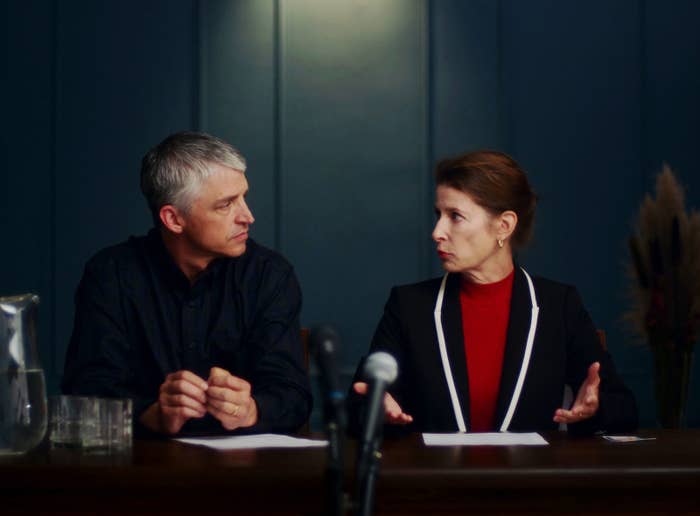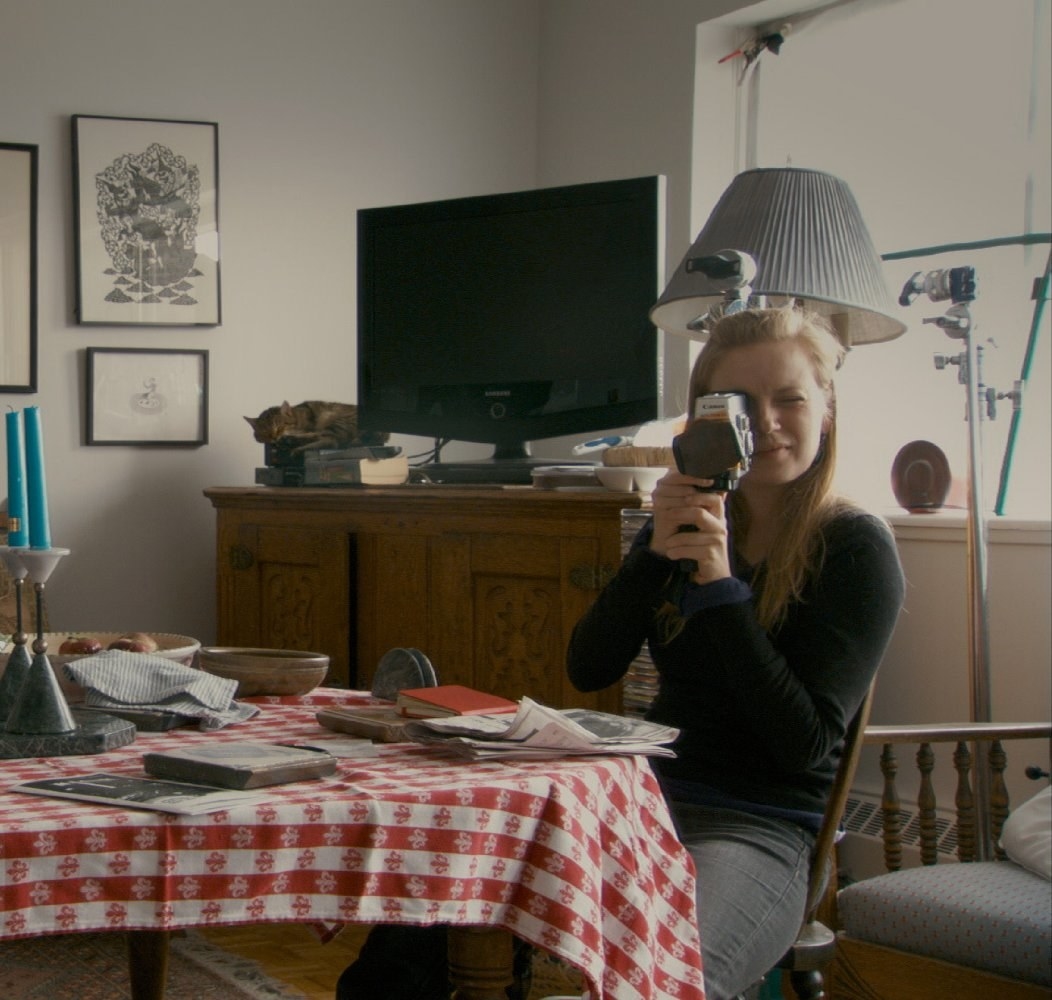
The opening shot of Casting JonBenet offers up a surreal, unsettling visual. The camera rests on a row of carefully arranged empty chairs, holding still for a few long, quiet seconds. Then, in a flurry of puffed sleeves and ballet slippers, a group of blonde girls rush in from outside the frame to take those seats. Each one is dressed in a replica of the red, white, and blue costume JonBenét Ramsey wore in one of the pageant photos that was widely circulated after her unsolved murder, at age 6, in 1996.
Eight child actors hoping to play the dead girl giggle and chatter excitedly onscreen before the scene cuts abruptly to one of them approaching the camera for an interview. “My name is Hannah, and I'm auditioning for the role of JonBenét Ramsey,” she announces, then asks, guilelessly, “Do you know who killed JonBenét Ramsey?”
Director Kitty Green does not know. Her intent is not to unveil new information about what happened that Christmas in 1996 in the Ramseys’ Boulder home. Nor is she interested in doing a traditional investigation and rehashing of the 21-year-old cold case in her documentary, which premiered on Netflix on April 28.

Casting JonBenet isn’t just a part of the current wave of true crime fare unfolding in movies and on TV — it’d be more accurate to say that the film is also about the genre of true crime itself, about the kind of transgressions that capture the national imagination and lead everyone following along at home to develop strong opinions and theories as to who did it, and why. It's about our obsession with certain unsolved mysteries that are writ large by the media — though “our” implies an inclusivity that the film doesn’t share, with its tendency to throw its interviewees under the bus in order to underscore its points.
To make Casting JonBenet, Green put a call out for Colorado-based actors to play the major figures in the case. In addition to the murdered JonBenét, there are her parents, John and Patsy; her brother, Burke, who was 9 at the time of her death; suspects John Mark Karr (who falsely confessed to the murder) and a neighborhood seasonal Santa Claus; and the local police chief. But the re-enactments these actors are trying out for, which primarily unfold on a soundstage version of the Ramseys’ house, are a means rather than end. It's their audition tapes that form the main part of the film.
In their tryouts, these dozens of would-be Patsys, Johns, and others become stand-ins for the public’s memory and perception of the case, which offered a perfect storm of awfulness, wealth, whiteness, child beauty pageant strangeness, and uncertainty to command outsized and lasting attention.

The would-be actors are prompted to share their theories, their knowledge, and their feelings of connection to the case, volunteering judgments on the character, the guilt or the innocence of various members of the Ramsey family, imagining sometimes lurid scenarios of what went down. One interviewee believes Patsy didn’t look convincingly grief-stricken to be without blame, while another, who experienced the murder of a loved one as a child, defends Patsy by saying there’s no predictable way to react to such a loss.
There are a few who think John did it, and more who target Patsy, while others suspect the couple were covering up for an accident involving Burke. Some blame the errant Santa, though the Santas, in turn, insist that’s preposterous because they’re too carefully screened.
The kaleidoscope of testimonials emphasizes the degree to which all of the interviewees, and the public at large they're supposed to be representing, project onto these incidents based on their own experiences and backgrounds. It underscores how presumptuous it is to believe that these real people and their real tragedy are at all knowable from afar.
Speaking to Vox about her film, Green noted the challenge of explaining her project to its participants, many of them non-pros who describe their day jobs or pull up their other performing experience. “Before we dressed them all up,” she said, “I'd give them a 15-minute spiel about how I envisioned the film coming together. Which is difficult, because it's not like any other film, so it's not really easy to describe!” But while Green’s tail-swallowing deconstructive set-up is definitely unlike the average documentary in terms of form, it’s not unique either. Casting JonBenet is one of few recent, boundary-pushing docs that have put the run-up to re-enactments front and center, using the acting process as a vehicle for investigation, introspection, or to prod at the audience.

Its closest sibling in are-you-not-entertained provocation is Robert Greene’s sharper Kate Plays Christine from last year, which centers on actor Kate Lyn Sheil’s preparations to play Christine Chubbuck, a Florida news reporter who killed herself on air in 1974. But there’s also My Scientology Movie, which opened in theaters in March, with TV host Louis Theroux auditioning actors as part of his look at the notoriously litigious church, selecting from them stand-ins for two people he knows he'll never get access to — Scientology leader David Miscavige and famous member Tom Cruise. And Alex Sichel’s 2015 A Woman Like Me incorporates self-aware re-enactments in still another way. Sichel, having been diagnosed with terminal cancer, hires Lili Taylor to play Sichel’s fictionalized self in scenes that are brighter and more theatrical — approaching death in a way she was able to control and script, unlike in real life.
Re-enactments have been a part of documentary since the early days, when Robert J. Flaherty had his Inuit subjects use spears to hunt a walrus instead of the guns they normally would in his 1922 Nanook of the North. Over the years, as the form has changed and grown, they've shifted from being treated as potentially deceptive to being a tool to get at a larger truth. Errol Morris, whose landmark 1988 The Thin Blue Line features the most famous use of re-enactments in the medium, wrote in 2008 about how objections to re-enactments imply that on-the-ground footage is innately factual, when it too is subjective. “There is no mode of expression, no technique of production that will instantly produce truth or falsehood. There is no veritas lens — no lens that provides a ‘truthful’ picture of events,” he insisted. “The engine of uncovering truth is not some special lens or even the unadorned human eye; it is unadorned human reason.”

In the era of fake news and reality shows that are mille-feuilles of real, staged, and staged-but-then-becomes-real, we have an ever more complicated relationship with the idea of “the truth.” It’s only made the documentary form more interesting and daring, embracing animation and artificiality, theater and experimentation.
Films like Sarah Polley’s Stories We Tell and Joshua Oppenheimer's The Act of Killing challenge, in different ways, the accounts we accept and why. Meta-documentaries like Casting JonBenet go a step further than calling attention to the stretchy subjectivity of memory and perspective. They raise the question of what, exactly, we in the audience hope to get from watching them.
That’s why these films focus on the ramp-up to a re-enactment rather than the re-enactment itself, which is secondary — the process is the point, not the end product. The shaggy My Scientology Movie isn’t the first or the most informative movie about Scientology, and Theroux is aware going in that getting attacked by the organization is likely to be the only form of contact he’ll successfully make with it. And so its use of actors seems mostly to emphasize the impossibility of the project: “We can’t get the real Miscavige, but we can create our own,” Theroux announces.
Chubbuck, the real figure Sheil studies and attempts to embody in Kate Plays Christine, is less known, and so for long stretches Sheil’s research into her life serves an informative purpose for viewers as well as an exploratory one for her. The more she wrestles with the role, trying to get into the headspace of someone who was depressed and lonely, and who remains famous only for how she died, the more the crux of Kate Plays Christine becomes not who Chubbuck was but what is gained from trudging back through her life this way other than grim voyeurism. When Sheil breaks the fourth wall at the end to castigate the audience, it’s a jarringly derailing moment, because that point was so clearly and more deftly made by everything that came before: Why is this something we want to see?

And why do we want to see a film about a dead little girl? Casting JonBenet culminates in a sequence of all of its actors on the soundstage together — fighting in the bedroom, crying on the stairs, a dozen possible versions of what happened unfolding in parallel, none of them any more certain than the others. It’s a virtuosic series of images, almost as striking as the one on which the film opens, and yet it suggests collaboration in a way that doesn’t really square with what came in between. In between, these actors — accommodating and eager to please because they’re trying to land roles — spilled details about their own painful personal histories, expounded on sometimes ugly impressions of the Ramseys, and had their side gigs presented as quirky details. Aware of it or not, they became the real subject of the movie.
There’s a resonant point to be made with their interviews, about the queasiness that can lurk there in the gawking at true tragedies, in the tendency to treat them as puzzles to be solved or as fuel for self-righteousness, or to turn them into a dark kind of entertainment. It’s a timely one, too, when the true crime genre is so resurgent and has been given a classy overhaul. But the way the auditions gets diced up into what are often instances of vanity, misogyny, and rubbernecking is inescapably glib — like the film is pointing a finger rather than holding up a mirror to habits the audience should see in ourselves, like it’s scolding rather than revealing.
Casting JonBenet’s inventive structure was crafted to instruct viewers to consider whether there’s something exploitative about our obsession with true crime. But in doing so it creates entire new issues about why we’d want to watch — not just an investigation of a tragedy, but also this self-referential meditation on it. Its participants sit in judgment of the Ramseys, and we in turn are set up to sit in judgment of them, a wheel within a wheel too many.
